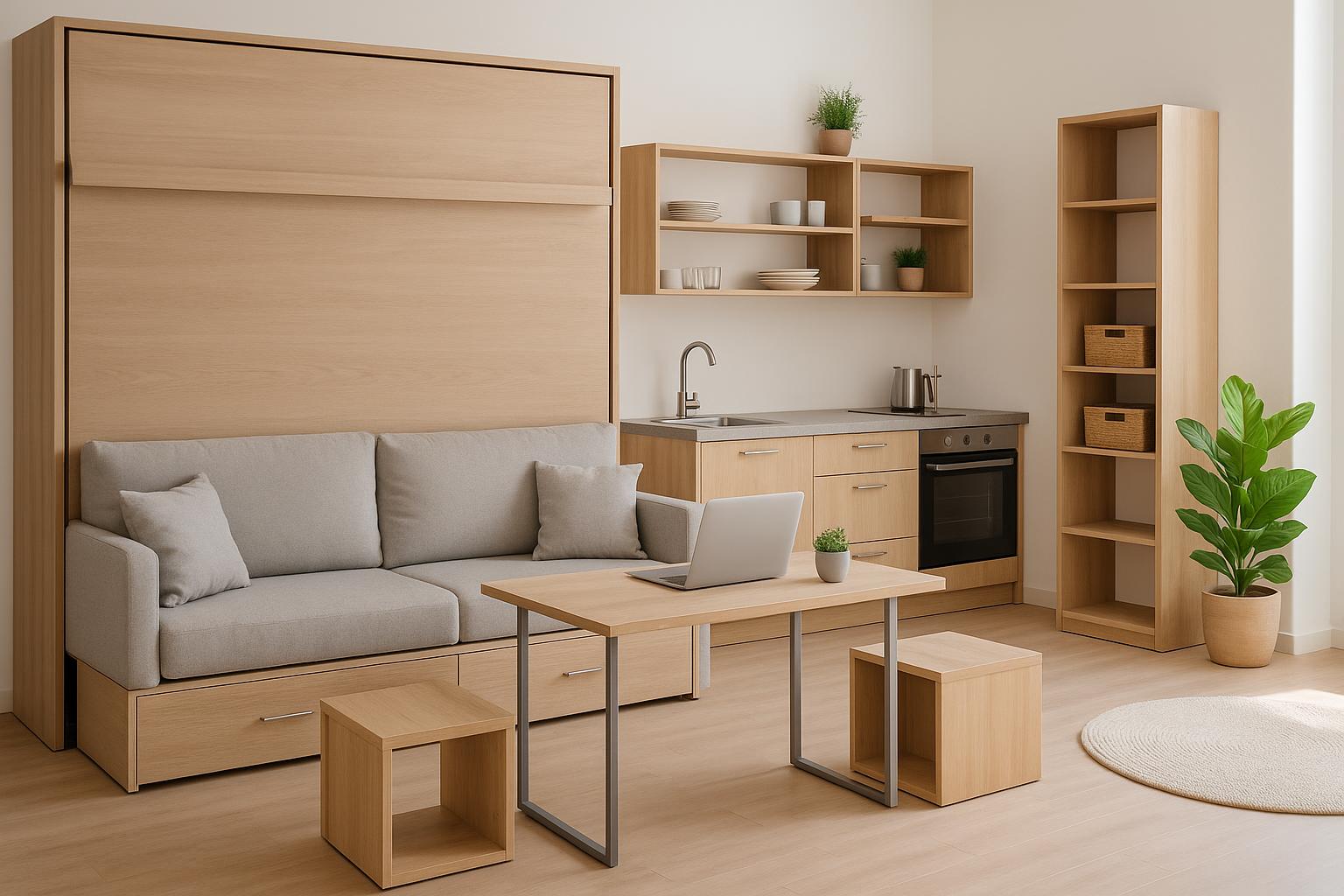
Modular Furniture for Tiny Homes: Space-Saving Innovations and Trends for 2025
Estimated reading time: 8 minutes
Key Takeaways
- Modular designers and suppliers are revolutionizing tiny home living in Canada with flexible, multi-use designs.
- Innovative materials and technology integrations help maximize limited space while supporting eco-friendly lifestyles.
- Leading Canadian suppliers like Minimaliste Houses, Mint Tiny House Company, and Teacup Tiny Homes set the benchmark for quality and sustainability.
- The future of modular furniture will see deeper smart tech integration and circular, sustainable design practices.
Table of Contents
Modular furniture for tiny homes is revolutionizing small-space living in Canada. These multifunctional, reconfigurable systems are designed to maximize compact areas—perfect for tiny homes and accessory dwelling units (ADUs). With the ongoing shift toward minimalist lifestyles and rising housing costs, modular furniture is not just a trend, it’s a necessity for modern living.
As real estate trends push homeowners to make every inch count, modular solutions provide flexibility, storage, and style. They adapt to your daily needs whether transforming a room from work space to living space or offering hidden storage to keep clutter at bay. As noted in Outbuilders – Tiny Home Show Ontario 2025: What To Expect, this design approach is rapidly gaining momentum.
The Rise of Modular Furniture in Tiny Homes
Why modular furniture fits tiny homes perfectly
Living in a tiny home requires that every inch works double duty. Rooms serve multiple purposes and clever storage solutions can make all the difference. Modular furniture adjusts to meet these challenges with flexibility and innovative design.
- Flexibility: Pieces that move, expand or compact as needed, such as a foldable bed that doubles as a couch.
- Customization: Adapt furniture layouts to suit changing daily requirements—a table can serve as both a desk and a dining area.
- High Functionality: Integrated storage options like hidden drawers, shelves, and vertical storage ensure clutter-free living.
With diminishing living areas and the rising desire for sustainable living, modular furniture has become a must-have accessory to enhance comfort and efficiency.
Key Innovations in Modular Furniture for 2025
The latest trends in modular furniture combine exquisite design with smart technology. Designers are pushing the boundaries with materials and integrations that enable even the smallest spaces to shine.
- Cutting-edge Materials:
- Lightweight, durable composites facilitate easy reconfiguration.
- Recycled and sustainable resources meet eco-conscious priorities.
- Fold-away Kitchen Systems: Innovative designs like the “Origami Kitchen” by Canadian designer Sarah Chen expand from compact units to full kitchens seamlessly.
- Vertical Wall Systems: Utilizing wall space for built-in shelving or even mini indoor gardens.
- Integrated Technology:
- Smart storage tracking and automated setup activated by apps ensure efficiency.
- Features like built-in charging surfaces and modular LED lighting are redefining convenience.
- Eco-friendly Finishes: Emphasis on reclaimed wood, non-toxic coatings, and sustainable practices.
These innovations not only enhance functionality but also promote sustainable living, a core value for modern Canadian tiny home enthusiasts. For more on these trends, see Outbuilders – Tiny Home Show Ontario 2025: What To Expect and this in-depth guide.
Spotlight on Space-Saving Furniture Trends for Tiny Homes
In today’s tiny home market, space-saving furniture is transforming daily living. Modern modular designs ensure that comfort and style are never compromised by limited space.
- Fold-away Beds: Murphy beds that elegantly disappear during the day.
- Convertible Sofas: Transformative seating that doubles as a guest bed.
- Expandable Dining/Work Tables: Tables that adjust to host a dinner party or offer a cozy work surface.
- Storage-integrated Seating and Stairs: Benches that double as drawers or cubbies.
- Wall-mounted, Fold-down Desks: Work surfaces that neatly vanish when not in use.
These trends illustrate a move towards multi-functional designs that combine beauty with practical use. Check out additional insights on compact living and smart storage design for urban homes.
Canadian Suppliers Leading the Modular Furniture Innovation in 2025
Canada boasts a host of pioneering companies dedicated to modular furniture design in tiny homes. Their innovative and customizable solutions are tailored to meet the demands of modern, small-space living.
1. Minimaliste (Quebec)
What they offer: Fully bespoke tiny homes with modular interiors you can customize down to the finest detail.
- Extreme adaptability: Layouts designed to suit work-from-home lifestyles, pet-friendly spaces, and growing families.
- Energy efficiency: High-efficiency heating, cooling, and solar integration options.
- Sustainability: Use of reclaimed or recycled materials and non-toxic finishes.
2. Mint Tiny House Company (BC)
What they offer: Modular ADUs that comply with local codes and include customizable furniture configurations for living, working, and sleeping in one compact unit.
- Durable design: Built to last with rigorous quality standards.
- Multipurpose modules: Adaptable systems that cater to various daily needs.
- Quick assembly: Minimal on-site work required for fast installation.
3. Teacup Tiny Homes (Alberta)
What they offer: Turnkey modular tiny homes and backyard suites delivered pre-finished and ready to inspire.
- Seamless delivery: Minimal on-site construction for hassle-free setup.
- Custom layouts: Interiors designed to maximize every precious square inch.
- Energy smart: Features optimized for off-grid or urban living with energy-efficient systems.
Each of these suppliers integrates eco-friendly practices—from reclaimed materials to solar-ready solutions—ensuring that your tiny home is both stylish and sustainable. For more details, visit Minimaliste Houses, Mint Tiny House Company, or Teacup Tiny Homes. Additional resources can be found on where to buy tiny homes in Canada.
How to Choose the Right Modular Furniture for Your Tiny Home
Choosing the perfect modular furniture in a tiny home blends creativity with practicality. Here are expert tips to maximize space and ensure comfort:
- Assess your space:
- Measure both floor and vertical areas meticulously.
- Plan traffic flow to avoid layout bottlenecks. See tips on tiny home design and space saving.
- Prioritize multi-functionality:
- Opt for beds with built-in drawers and convertible tables.
- Select seating that doubles as storage or even a guest bed.
- Match your style and budget:
- Choose finishes that complement your home’s aesthetic—be it modern or rustic.
- Invest in durable pieces that offer long-term versatility.
- Check supplier credibility:
- Read reviews and assess warranty and aftersales support.
- Request testimonials or case studies to gauge reliability.
- Plan for the future:
- Choose designs that reconfigure as your needs evolve—be it for remote work, hosting guests, or new hobbies.
Future Outlook: What to Expect in Modular Furniture Beyond 2025
As modular furniture continues to gain traction, the next frontier promises even more innovative solutions:
- Deeper Smart Tech Integration: Expect modular systems with wireless controls, voice activation, and automated adjustments.
- Sustainability as Standard: Greater adoption of upcycled, recyclable, and non-toxic materials, culminating in a circular design approach.
- Broader Market Appeal: From urban condos to student units, modular solutions will redefine small-space living everywhere.
Innovations in smart tech and sustainability are setting the stage for modular furniture to continually transform tiny home living. More insights on future trends can be found at Innovative Urban ADU Design in Canada.
Conclusion
Modular furniture for tiny homes is at the forefront of the space-saving revolution in Canada. As affordability challenges and minimalist lifestyles drive demand, these versatile systems offer both beauty and utility. From fold-away beds to smart storage, each innovation is tailored to maximize every square foot without compromising style.
With leading Canadian suppliers providing highly customizable, sustainable options, the future of tiny home living looks smarter and more connected than ever. Explore these solutions and transform your home into a haven of efficiency and modern design.
Frequently Asked Questions
Q1: What makes modular furniture ideal for tiny homes?
A1: Modular furniture is designed for versatility. It adapts to multiple uses—from convertible seating and beds to hidden storage—making every inch of a tiny home work harder.
Q2: How do I choose the right modular pieces for my space?
A2: Begin by assessing your space and prioritizing multi-functional items. Consider your lifestyle needs, check supplier reviews, and look for pieces that offer customization and future flexibility.
Q3: Are the materials used in modular furniture eco-friendly?
A3: Yes, many modern modular pieces incorporate sustainable materials such as recycled composites and reclaimed wood, as well as non-toxic finishes to ensure both durability and environmental responsibility.
Q4: What trends can we expect to see in modular furniture in the future?
A4: Look forward to deeper smart technology integration, enhanced sustainability with circular designs, and broader appeal that blends functionality with modern aesthetics.

Leave a Reply